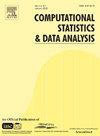Fast and efficient causal inference in large-scale data via subsampling and projection calibration
IF 1.6
3区 数学
Q3 COMPUTER SCIENCE, INTERDISCIPLINARY APPLICATIONS
引用次数: 0
Abstract
Estimating the average treatment effect in large-scale datasets faces significant computational and storage challenges. Subsampling has emerged as a critical strategy to mitigate these issues. This paper proposes a novel subsampling method that builds on the G-estimation method offering the double robustness property. The proposed method uses a small subset of data to estimate computationally complex nuisance parameters, while leveraging the full dataset for the computationally simple final estimation. To ensure that the resulting estimator remains first-order insensitive to variations in nuisance parameters, a projection approach is introduced to optimize the estimation of the outcome regression function and treatment regression function such that the Neyman orthogonality conditions are satisfied. It is shown that the resulting estimator is asymptotically normal and achieves the same convergence rate as the full data-based estimator when either the treatment or the outcome models is correctly specified. Additionally, when both models are correctly specified, the proposed estimator achieves the same asymptotic variance as the full data-based estimator. The finite sample performance of the proposed method is demonstrated through simulation studies and an application to birth data, comprising over 30 million observations collected over the past eight years. Numerical results indicate that the proposed estimator is nearly as computationally efficient as the uniform subsampling estimator, while achieving similar estimation efficiency to the full data-based G-estimator.
基于子采样和投影校准的大规模数据快速有效的因果推理
估计大规模数据集的平均处理效果面临着重大的计算和存储挑战。子抽样已成为缓解这些问题的关键策略。本文提出了一种新的基于g估计的子抽样方法,该方法具有双鲁棒性。该方法使用一小部分数据来估计计算复杂的干扰参数,同时利用完整的数据集进行计算简单的最终估计。为了保证得到的估计量对干扰参数的变化保持一阶不敏感,引入了一种投影方法来优化结果回归函数和处理回归函数的估计,使其满足内曼正交条件。结果表明,当正确指定处理模型或结果模型时,所得估计量是渐近正态的,并且与完全基于数据的估计量具有相同的收敛速率。此外,当两个模型都正确指定时,所提出的估计量与完全基于数据的估计量获得相同的渐近方差。通过模拟研究和对出生数据的应用,证明了所提出方法的有限样本性能,这些数据包括过去8年中收集的3000多万次观察结果。数值结果表明,该估计器的计算效率几乎与均匀次抽样估计器相当,而估计效率与基于全数据的g估计器相似。
本文章由计算机程序翻译,如有差异,请以英文原文为准。
求助全文
约1分钟内获得全文
求助全文
来源期刊

Computational Statistics & Data Analysis
数学-计算机:跨学科应用
CiteScore
3.70
自引率
5.60%
发文量
167
审稿时长
60 days
期刊介绍:
Computational Statistics and Data Analysis (CSDA), an Official Publication of the network Computational and Methodological Statistics (CMStatistics) and of the International Association for Statistical Computing (IASC), is an international journal dedicated to the dissemination of methodological research and applications in the areas of computational statistics and data analysis. The journal consists of four refereed sections which are divided into the following subject areas:
I) Computational Statistics - Manuscripts dealing with: 1) the explicit impact of computers on statistical methodology (e.g., Bayesian computing, bioinformatics,computer graphics, computer intensive inferential methods, data exploration, data mining, expert systems, heuristics, knowledge based systems, machine learning, neural networks, numerical and optimization methods, parallel computing, statistical databases, statistical systems), and 2) the development, evaluation and validation of statistical software and algorithms. Software and algorithms can be submitted with manuscripts and will be stored together with the online article.
II) Statistical Methodology for Data Analysis - Manuscripts dealing with novel and original data analytical strategies and methodologies applied in biostatistics (design and analytic methods for clinical trials, epidemiological studies, statistical genetics, or genetic/environmental interactions), chemometrics, classification, data exploration, density estimation, design of experiments, environmetrics, education, image analysis, marketing, model free data exploration, pattern recognition, psychometrics, statistical physics, image processing, robust procedures.
[...]
III) Special Applications - [...]
IV) Annals of Statistical Data Science [...]
 求助内容:
求助内容: 应助结果提醒方式:
应助结果提醒方式:


